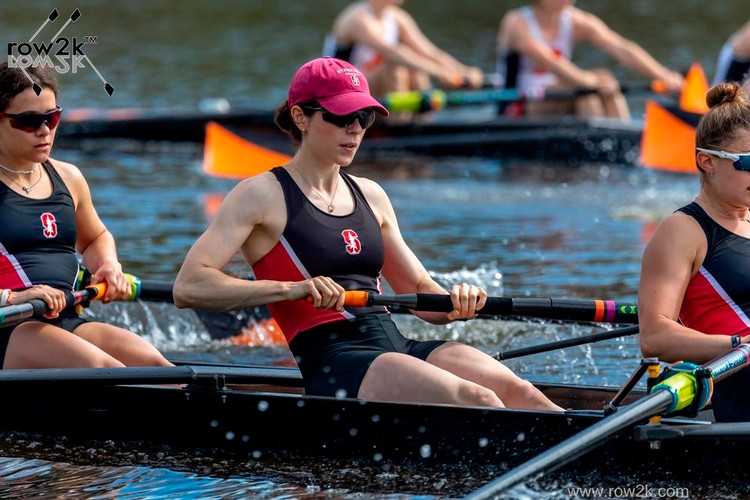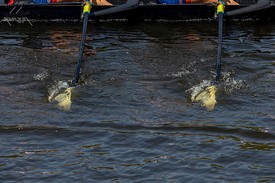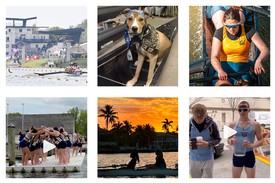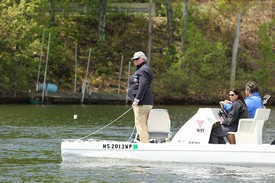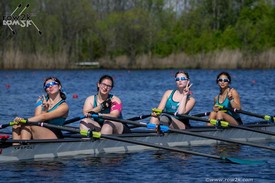row2k starts off our 2024 spring collegiate racing preview with an interview with Stanford lightweight grad student Emily Molins. We chat with Molins on finding the sport after health issues, legacy, and more.
row2k - How did you get your start in rowing?
Emily Molins -
I grew up in a very athletic family, so trying out every sport under the sun was somewhat of a rite of passage. Truthfully, there was a good stretch of time that I thought lacrosse was going to be my niche. But, like a number of members of the rowing community, I ended up finding rowing after some health road bumps. I was diagnosed with an arteriovenous malformation (AVM) in middle school and put a pause on physical activity for a few years to undergo treatments. When I was cleared to try a non-contact sport my first year of high school, I jumped at the idea of joining my local rowing team because it was both a team sport and sitting down (so it couldn’t be too hard?). My dad, who had walked on to Georgetown’s team in college, thought it was going to be a disastrous return to sports, but I’m fairly certain he’s glad I’ve stuck with it.
My freshman winter I started at North Suburban Crew, an all-girls team that pulls from local high schools. Despite my rusty athleticism, coaches Heather LaVigne and Josh Karney were incredibly patient with me. That next year I transferred to Loyola Academy and joined the school’s rowing team. Under coaches Matt Baldino and Mike Kelley, I grew to love rowing for the strength it fostered and the sense of empowerment I felt. It’s a sport that I can confidently say changed my life, and those early coaches are a large reason why.
row2k - How did you decide to attend Stanford?
Emily Molins -
The summer before my junior year of high school I visited Stanford for the first time. After two years of rowing along the Skokie canals north of Chicago, I had found myself really enjoying getting back into exercising and learning about the technical side of this new sport. Cautiously optimistic, my parents signed me up for a rowing camp at Stanford. I loved everything about that week: the coaches, the quirky atmosphere, the mornings on the Bay. At the end of the camp, the then head lightweight coach Derek Byrnes stopped me and told me that if this is something that I wanted, it was possible. Stanford came to represent just that–this sense of limitless possibility–and I knew after that summer it was the place I wanted to learn and train at and be shaped by.
row2k - You’ve raced multiple times at the U23 championships, what were those regattas like and what is one of your key takeaways from those experiences?
Emily Molins -
In my mind, my experiences at the 2019 and 2021 U23 world champs could not have been more different. However, they did have one thing in common: the caliber of people. In both Sarasota (2019) and the Czech Republic (2021) I had training partners who were fantastic athletes and even better friends: Sarah Maietta, who continues to leave her mark on the lightweight community in Boston, and Lanie Tierney, who keeps crushing it on the international stage with the utmost grace. I was also blessed with coaches who led with a love for this sport both on and off the water: Malcolm Doldron and Molly Hamrick in ‘19, who has since made Stanford her home(!), and Andriel Doolittle and Steve Whelpley in ‘21, both exceptional coaches and people.
In 2019, I had just finished my freshman year at Stanford and spent much of that summer trying to prove to myself that this group of impressive college athletes and U23 veterans was one I belonged in. Those weeks imparted many lessons, especially the importance of having the guts to start somewhere (I did flip my single our first day training on the Charles). Two years later, I arrived at 2021 U23s after spending a Covid gap-year training at Craftsbury under coaches who I wanted to make proud with a training partner I wanted to see succeed. While I felt more experienced this time around, I was also sick. After complications with my AVM and sepsis earlier that spring, I had decided to delay surgeries for summer racing. The weeks leading up to U23s had been a balancing act of rowing and maintaining my health. I learned the hard way that summer that health is not something that can be postponed, even when the timing feels unbearable.
row2k - What do you like most about the sport of rowing?
![Molins with Craftsbury]()
Molins with Craftsbury
Emily Molins -
I remember early into my time at Craftsbury Coach Steve Whelpley saying something along the lines of “Rowing is the Ellis Island of sports: come willing to work hard, and you will find a home.” That–the ability to find a home in the sport of rowing regardless of age, gender, ability, race, background–is my favorite aspect about rowing. I found this sport when I was a kid angry at the world and struggling to find my place. Ten years later, after over a dozen operations and many steps back, rowing remains a home for me. Morning sessions on the water and afternoon ergs remind me that I am strong, capable, and so very alive; I can’t think of a better way to start and end my day.
row2k - What has been your most memorable race and why?
Emily Molins -
The finals of the 2022 IRA championships will always be my most memorable, both for what competing meant for me and my team. Stanford Lights had been through an unimaginably rocky past year with the team being cut, eventually reinstated, and experiencing coach changes. Entering the season, I was recovering from tougher surgeries that early fall and was unsure if competing was in the cards for me. To say getting on the IRA podium was a team effort would be an understatement. Every single eligible athlete on our roster raced that weekend (pause to think about that). And that June, surrounded by the grittiest group of women I know, we raced competitively in every event. Being able to bookend the 8+ with my little sister in bow makes it a race I will forever be grateful for.
row2k - The Stanford Lights have been through a lot of ups and downs during your career, how have you grown as a person/athlete during your time at Stanford?
Emily Molins -
Crossing the line with open water in the 8+ at IRAs my freshman year, I remember feeling determined to spend my next three years upholding the legacy of the winningest lightweight women’s team. But it didn’t feel like a pipe dream; it felt like the standard. Our roster was brimming with fast athletes committed to the end goal. We were rowing under Coach Kate Bertko, who embodied everything I aspired to be like in this sport: a compassionate coach, a phenomenal athlete, and an extraordinary leader. Winning was going to be like second nature.
One year later, our team was one of the eleven to be eliminated by Stanford. After participating in a collective effort to save our sport over the ensuing months, it was announced that Stanford Lights would be reinstated. Yet, following the immediate joyful celebrations crept uncertainty. What would be the state of our team? We had lost a year of recruiting athletes and were losing our coaches, leaving those of us who remained wondering where the Stanford Lights legacy would be.
These last two years have felt worlds away from my freshman year. Our team is half its size and incredibly young, with one junior and four seniors. A success that was once a given is now one that needs to be earned. Placing third in the 8+ at IRAs in 2022 and second in 2023, we are learning from new coaches Lizzy Houston and Antonella Kugler how to move the needle forward each day.
If my time here has taught me anything, it’s that a legacy is built and not simply handed down. I entered college rather shy and quiet, not one to rock the boat or voice my opinions. Being older now, I still prefer to lead by example, but I’ve learned that there are times to speak up and to stand up for what you believe in, whether it’s a decision that you believe is unfair or a future that you believe needs protecting. To be a Stanford Light is to be actively carrying on the legacy of the strong, hard-working, smart, and kind women who preceded you and to ensure that there is a path for more young women to follow.
row2k - You have spent a summer as an intern at the White House. How did you come about that internship, what did it entail, and what did you learn from that experience?
Emily Molins -
After graduating last spring, I was interested in exploring the government policy space and thought the Executive Office would be the perfect place to do just that. The OMB offered the ideal vantage point to gain a better understanding of federal agencies and policy initiatives. I loved the variety of projects thrown my way, from developing financial forecasting models for mandatory spending to incorporating climate change considerations into economic planning. I finished my time in D.C. with a much deeper appreciation for the role of policy in translating research to impact. I also realized that my current passion lies more in frontline research than in policy formulation. These past months I’ve leaned heavily into just that, working with a favorite computer science professor of mine, Prof. Mykel Kochenderfer, and doctors from Stanford Hospital to evaluate California stroke triage protocols. In the future, I plan to continue researching systems design and algorithmic decision-making with a focus in healthcare applications and social good.
row2k - What are you studying at Stanford and do you have any plans for after graduation?
Emily Molins -
I’m currently a masters student in management science and engineering studying computational social science, which is a fancy way of saying that I’m interested in how we can leverage computational tools and data to better understand social phenomena. With an extra year of eligibility, I had decided to stay one more year to row and finish my grad program. That one year has now extended into two, and I’ll be delaying graduation to complete pre-med requirements. I had always thought that health was too hard of a problem for me to tackle (both academically and emotionally), but I’ve come to the realization that that's exactly the type of problem I want to spend my life working to address. Plus, it means I get to spend another year in school with my two little sisters–Chloe, who just started her freshman year here, and Sophie, a junior on the team–which feels particularly special.
